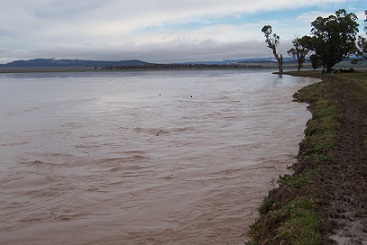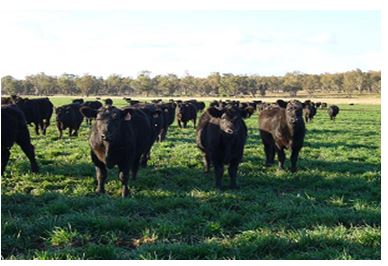Dual purpose crops
Author: Keith Harris | Date: 23 Feb 2016
Take home message
- Advantages of dual purpose crops include minimising risks, capitalising on early rainfall events, flexibility in enterprise mix, and improved cash-flow
- Dual purpose crops require a high standard of management
- Ideal grazing facilities would allow for an excellent water supply, shelter belts, rotational grazing, and drafting cattle into similar weight ranges before being placed onto grazing crops. Try to minimise handling and ensure that all animal health issues are addressed.
Many farmers would be aware that I have been promoting the benefits of growing dual-purpose crops for several decades and in particular over the last 12 years whilst managing the Romani Pastoral Company owned Northern properties, including Windy Station.
Windy Station, a 20,000 Ha property located on the Liverpool Plains, is better known as a major cropping property with very fertile cracking clay soils. Unfortunately, these rich black Vertosol soils are the result of hundreds of years of extensive flooding from the neighbouring hills and the Murrurundi Range located to the south of the Property. It is not uncommon to see up to 2,000 Ha of some of Windy's most fertile country affected by floodwaters.
On my arrival at Windy an analysis of paddock cropping performance identified that the same paddocks consistently appeared in the bottom 20%, due mainly to flooding, waterlogging, poor drainage, planting issues etc. and therefore these paddocks were consequently re-allocated as forage crops or pastures.

Figure 1. Floods on Windy Station - at least 3 years in 5.

Figure 2. Windy Steers grazing 'Naparoo Wheat'
Windy management decided the best way to protect their topsoil from increased erosion was to slow the water flow through the property, particularly on the low lying flood prone areas, even if it required the re-establishment of improved pastures or favouring winter forage or dual-purpose crops.
Many farmers believe that running livestock on these quality self-mulching black soils of the Liverpool Plains was only asking for trouble, and that particularly cattle would cause irreversible damage through increased soil compaction.
Windy Management have found that most of our self-mulching black soils have the ability to self-repair after a normal wetting and drying period. These soils rapidly crack open when dried through lack of rain, which enables water infiltration next time it rains. Our experience suggests that there are only minor losses, if any, in subsequent crops after grazing, and we believe the opportunity to grow dual-purpose crops on these types of soils has not been fully utilised.
Soil compaction limits root development and slows water infiltration which may potentially increase soil erosion, however several GRDC funded or partly funded projects have supported Windy's observations.
Windy Management decided that they needed to re-classify some of the cash-cropping areas in an attempt to reduce the risk of substantial crop failure due to potentially untimely flooding. Over the years the flooding intensity had increased through Windy, particularly after many farmers on the neighbouring slopes had constructed soil conservation works, including new contour banks, drainage channels and waterways.
Benefits of growing dual purpose or winter forage crops
1) Minimises risks
- Floods close to grain harvest have caused or can cause severe damage to ripening crops
- Floods during the growing period of grazing crops can provide irrigation-type benefits
- Floods in November/December on grazing crops are not so critical as benefits are already banked
- Minimises the risks associated with dry periods late winter/spring such as 2013/2014/2015.
2) Capitalises on early rainfall events
- Grazing or dual-purpose crops can be planted in late February (Oats) & late March (Wheat) thus capitalising on late summer rainfall events. It also spreads workloads!
- Early sown crops will provide quality feed from mid-May most seasons.
3) Flexibility in Enterprise Mix
- It isn't totally reliant on grain prices/export markets/grain quality issues/downgrading weather damage etc.
- Buying and selling trading cattle - there are budget profits from weight gains
- There is the opportunity to background cattle for feedlots and the potential to lock in sale price at purchase
- In most cases cattle prices at feedlots are higher when grain prices are down. Obviously grain is a major input cost for feedlots and therefore it has a major impact on feedlot margins
- The decision to lock up dual-purpose crops does not need to be made until late July. During a normal average season when late winter/early spring feed reserves (pastures) are looking good dual-purpose crops can be locked up/top dressed/weed controlled if necessary and kept for grain production. Unfortunately current northern area dual purpose varieties do not yield as well as the southern or central NSW EGA Wedgetail wheat variety.
- Obviously growers could also elect to continue to graze their crop, taking into account cattle & grain prices/stored soil moisture levels/seasonal outlook etc.
4) Improved cash-flow
- Dual purpose crops offer the benefit to generate early income from the start of the grazing period. Cattle are often sold after 70 days of grazing in late July and after achieving a weight gain of between 90-120 kg/head (budget 70 days x average 1.6kg/head/day for a good crop).
- Remember you don't need to finish the cattle, best returns are often obtained from backgrounding cattle for local feedlots. A good idea is to speak with the feedlot before you buy the cattle, or there may be an opportunity to background cattle on their behalf, being paid for the weight gain only.
- A well-managed forage crop can provide sufficient early season feed for up to 5 weaners/ha. Therefore early income potential paid in August should realise well over $1,000/Ha.
- No need to wait until December or January (6-8 months) to realise cash-flow
- Dual-purpose crops grain recovery in northern areas should budget 50% of un-grazed crops.
Dual-purpose crops demand high standard management
We should stress that for a dual-purpose crop to be as or more profitable than grain-only crops in this prime Australian grain growing area the standard of management needs to be just as high for it as it is for grain-only crops.
Whilst this sounds logical, detractors of the logic of high value dual-purpose crops all too often compare results from far less, poorly prepared and poorly managed grazing crops.
Attention to soil fertility needs to be at least as good, especially as dual-purpose crops demand high soil nitrogen if high production is to be achieved. Weed control needs to be of a high standard, and the dual-purpose wheat crops place in the overall property rotation also needs to abide by the same rules as those which apply to grain-only crops to reduce risk of disease, weed and nematode issues.
We believe that grazing winter forage crops on Windy Station in recent years has been one of the highest returning 'gross margins' and that the advantages of growing dual-purpose winter cereals is highly underrated, particularly in Northern NSW.
Windy Station has achieved average weight gains in weaner steers of between 1.2 kg/head/day up to a staggering 2.44 kg/head/day over grazing periods between 70 to 130 days on forage oats or wheat.
Obviously not all farm layouts are suitable for effectively growing forage or dual-purpose crops. However, where possible growers should consider this option around early planting dual-purpose winter forage crops which can provide quality early winter feed and which can be locked up for grain recovery.
Ideal grazing facilities would allow for an excellent water supply, shelter belts, rotational grazing and drafting cattle into similar weight ranges before being placed onto grazing crops. Try to minimise handling and ensure that all animal health issues are addressed.
No doubt having an ideal environment for grazing cattle had the ability to lower stress within the animals and this is without doubt one of the prime considerations in maximising weight gains. A trial with a mineral supplement called Causmag (magnesium cobalt) demonstrated a 20% weight gain over similar steers grazing wheat without Causmag.
However, cattle being grazed in our specifically established ideal grazing environment achieved an additional 20% without the Causmag supplement. We believe the Causmag lowered stress levels in cattle, however by following protocols the ideal environment will achieve weight gains similar to that achieved in feedlots.
Table 1. Gross margin summary comparison between wheat only, grazing only and dual purpose crops.
|
Gross Margin Summaries |
Wheat only |
Dual Purpose |
Grazing Only |
||||||
|
Income: Wheat $280/t |
5.0 t/Ha |
$ 1,400.00 |
2.5 t/Ha |
$700.00 |
nil |
||||
|
Grazing: 70 days x 1.6 x $2.80/kg x 4 head |
$1,254.40 |
||||||||
|
Grazing: 100 days x 1.6 x $2.80/kg x 4 head |
1,792.00 |
||||||||
|
Total Income/Ha |
$ 1,400.00 / Ha |
$ 1,954.40 / Ha |
$ 1,792.00 / Ha |
||||||
|
Expenses |
|||||||||
|
Seed |
$44.00 |
$44.00 |
$ 44.00 |
||||||
|
Fertilizers and top dressing |
$149.20 |
$209.20 |
$209.20 |
||||||
|
Chemicals - Weed Control |
$ 58.80 |
$58.80 |
$58.80 |
||||||
|
Harvesting |
$68.00 |
$58.00 |
|||||||
|
Freight to sale |
$110.00 |
$55.00 |
|||||||
|
Workings: Spraying, Slashing, Planting, etc. |
$144.00 |
$160.00 |
$160.00 |
||||||
|
Cattle ownership: interest, animal health, etc. |
$58.40 |
$83.43 |
|||||||
|
Total cost/Ha |
$574.00 / Ha |
$643.40 / Ha |
$555.43 / Ha |
||||||
|
Gross Margin |
$826.00 / Ha |
$1,311.00 / Ha |
$1,236.57 / Ha |
||||||
We should note that cattle prices have risen by 30% in last 12 months which make these figures very conservative.
Acknowledgements
Please note for additional information we suggest you read associated GRDC funded results on the GRDC website, including papers
- Grazing effects did not drive yield loss in black Vertosol Soils by Dr Chris Guppy et al.
- Feed mineral supplements when grazing cereals by Dr Lindsay Bell & Dr Hugh Dove
Contact details
Keith Harris
Mb: 0428 157 754
Email: kharris@romanipastoral.com.au
Was this page helpful?
YOUR FEEDBACK
